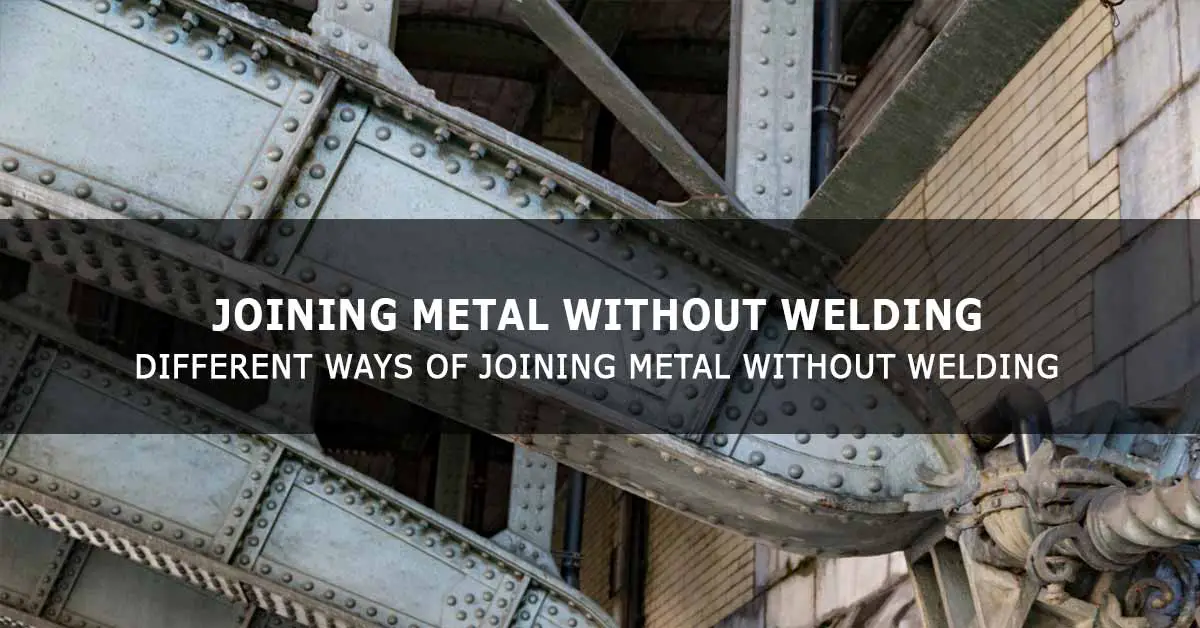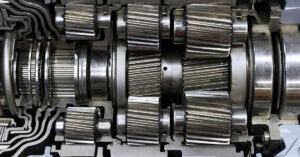Fusion welding is an important and predominant process in metal fabrication, but you may sometimes face difficulties in adopting welding and want alternate methods to join metals without welding. If you are searching for joining metals without welding, this article is for you. Come, let us explore.
What is the need for joining metals without welding?
We may often have to adopt a method other than fusion welding for joining two or more metals. There can be many reasons, and some common reasons are compiled below:
- Some metals have metallurgical incompatibility, and fusion welding is not practical or does not produce a sound joint (combination like aluminum to steel or aluminum to copper).
- There are metals with poor weldability, and attempting to weld them can lead to cracks, metals reacting with the atmosphere to lose their properties, etc.
- Every joint in a metal fabrication need not be welded. Many joints come under moderate load and working temperature, and a brazed joint may be acceptable.
- Sometimes, you need joints that you want to disassemble and assemble when required. Such joints are possible by using mechanical fasteners.
- For works like building a body for passenger cars or busses, joining by riveting can be a neat and clean alternative to welding.
How to join metals without welding?
The different techniques of joining two or more metals without welding are:
- Bonding the metals with glue.
- Brazing.
- Soldering.
- Riveting.
- Using mechanical fasteners.
1. Bonding the metals with glue
You can use this method for joining lightweight metal parts and where the assembly does not come under force or heat. Glues like epoxy, polyurethane, or silicon-based glues can be good for joining lightweight metals. You can do this in the following steps:
Step 1 – Ensure the workpieces to be joined match perfectly with each other.
Step 2 – Clean the workpieces to remove all contamination. Use sandpaper to make the bonding area slightly rough. Ensure the bonding area is clean.
Step 3 – Apply the recommended glue on the bonding area using a brush or spatula.
Step 4 – Assemble the workpieces and clamp the assembly using suitable clamps or in a fixture. Make sure there are no gaps in the joint.
Step 5 – Allow the bonded assembly to cure for 12 hours or as recommended by the glue manufacturer.
Step 6 – Take out the bonded assembly and use it after inspection.
Note: Do this in a well-ventilated area and take recommended safety precautions.
2. Brazing
You can define brazing as a process of using heat to melt the filler metal and join or braze two metals. The heat source can be a gas torch, induction coil, or furnace, and the molten filler metal flows into the brazing joint due to capillary action.
Unlike in welding, the base metals will remain in the solid state in the brazing, and the filler metal with a melting point much lower than the base metal melts and fills the joint. The molten filler metal solidifies to form a brazed joint.
To achieve a good brazed joint, it is important to have the base metal clean (without contaminations and oxides on the surface) and a recommended joint clearance. Contamination affects the flowability of the molten filler metal, and joint clearance is important for capillary action. Brazing is done at an approximate temperature of 800º F/426º C or more.
It is essential to apply flux on the brazing joint to protect the base metal and molten filler metal from oxidation and bring all leftover contaminants as slag to the joint’s surface. The traces of flux are cleaned after brazing since it is highly corrosive.
Different types of brazing are DIY brazing using home brazing kits, torch brazing, brazing using induction heat, dip brazing, and furnace brazing.
3. Soldering
Soldering is similar to brazing, but it is done at much less temperature than brazing (180º C to 275º C/356º F to 527º F). The filler metal (called solder) used is typically alloys of tin and lead, or tin with very few quantities of copper, zinc, and silver, and flux is used to eliminate oxide formation. Solder metal with higher tin content will have a low melting temperature.
Like in brazing, having clean soldering surfaces and recommended joint clearance is very important for good capillary action and to get a good solder joint. Soldering is a preferred process for joining connections on electrical and electronic boards.
An electric soldering iron is used for soldering. Plug the soldering iron. Clean the soldering surfaces using sandpaper and chemical cleaners. Dip the soldering iron in the flux, apply it to the joint, and melt the solder metal. The molten solder metal bonds the parts with soldering. Scrap out excess solder, if any.
4. Riveting
When you have traveled on a train or a bus, you might have observed that the body and roof of the bus or the train coach are made using the riveting process.
You can join two overlapped sheet metals (arranged like a lap joint) by riveting them. Clean the metal surfaces, and clamp them in the overlapped condition. If the metal sheets are thin, you can mark and punch holes for riveting; however, the thick gauge needs to be drilled.
The rivets used can be aluminum, brass, or copper and have a rivet head on one end. Insert the rivet into the hole, place a rivet head forming tool on the other end and hammer it to form the head (you can hammer without using a rivet head forming tool, but it may not look good). Once you have completed riveting, allow it to cool and form a strong joint. The metal sheets can be trimmed, assembled, and painted. Riveting is helpful for supporting shear loads.
You can also use riveting guns for light works.
5. Using mechanical fasteners
Often, you need large metal fabrications that are not practical to make in one piece, and examples can be a machine frame, a machine base, etc. In such cases, splitting the total fabrication into two or more small fabrications and then assembling them together using nuts, bolts, and washers (fasteners) can be advantageous. The advantages are ease of manufacturing, ease of transportation, and many more. Once you assemble the sub-fabrications together using the fasteners, it becomes a single sturdy item.
This idea is expanded further, and the result is in front of you. You may think of your car, motorcycle, bicycle, and many such machines as one unit. Still, it consists of many individual parts put together in the desired manner using fasteners. Any machine you name, be it a locomotive, passenger bus, airplane, they have numerous parts joined together using fasteners and other modes.
Unlike in welding, brazing, or soldering, you can disassemble a unit assembled with fasteners any number of times and put them back together.
Joining aluminum without welding
Aluminum is a popular metal due to its many qualities, including its high strength to weight ratio. Apart from welding, you can join two or more aluminum parts by the following methods:
- Using adhesives.
- Brazing.
- Soldering.
- Riveting.
- Using mechanical fasteners.
Using adhesives: You can prepare the aluminum surfaces as discussed in the previous paragraphs and use a recommended glue, like epoxy, silicone-based glue, etc. Follow the instructions of the glue manufacturer to get a good bonding.
Brazing: For a complete understanding of brazing aluminum, you can refer to our article “How to braze aluminum.”
Soldering: You can follow the soldering process discussed in the previous paragraphs. Use a flux and soldering metal recommended for soldering aluminum.
Joining by riveting and mechanical fasteners: These processes are the same as discussed in the previous paragraphs.
Joining Stainless steel without welding
You can join two or more stainless steel parts by the following methods:
- Using adhesives.
- Brazing.
- Soldering.
- Riveting.
- Using mechanical fasteners.
Using adhesives: You can use this method for joining lightweight stainless steel parts. The process is the same as discussed in the previous paragraphs; however, you must use an adhesive recommended for stainless steel. This is suitable for joining artworks that do not come under load.
Brazing: The brazing process will be similar to the process discussed in the previous paragraphs and use a flux and filler metal recommended for stainless steel. A combination of nickel and copper can be used for brazing stainless steel (brazing temperature is 1120º C/ 2048º F).
Soldering: You can join two stainless steel plates by soldering, and the soldering metal used can be an alloy of tin and silver (96.5% tin and 3.5% silver). The stainless steel plates are cleaned, and the flux is applied. A foil of the soldering metal is sandwiched between the two stainless steel plates to be soldered, and the sandwiched assembly is heated to around 220º C/428º F.
MAPP torch unit can be used for heating. The soldering metal foil melts and bonds the two stainless steel plates by soldering. The soldered workpiece is washed in hot water and cleaned with a stainless steel wire brush.
Riveting: You can join two overlapped stainless steel sheets by riveting. The material grade of the rivet should be the same as the base metal (AISI 304, 316, etc.). Insert the rivet into the drilled hole, place the rivet head forming tool on the other end of the rivet, and hammer to form the head and join the sheets.
Since stainless steel is a tough metal, apply a lubricant on the rivet before hammering, and the impact required will be more.
Using mechanical fasteners: The process is the same as discussed in the previous paragraphs, and stainless steel-grade fasteners are typically used.
Related Article: Welding VS Brazing | What Is The Difference?
Conclusion
Fusion welding may not be a standard solution always for joining two or more metals, and when you face trouble in welding, knowing the alternate ways of joining metals can give a solution to your problem.
References:







